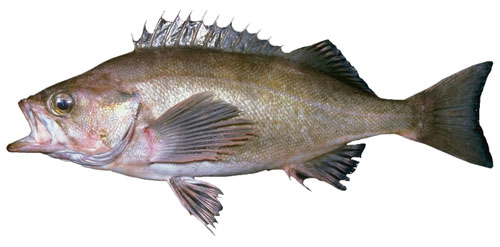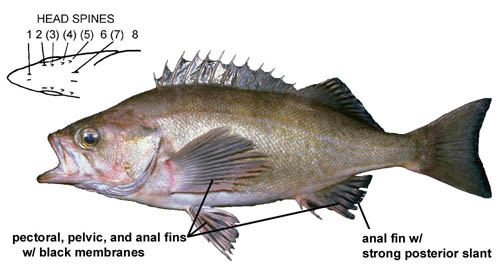|

The widow rockfish (Sebastes entomelas)
was called buda by the Monterey (California) fishermen in the 1880s, and
was known as beccafico (Italian bird) and viuva (widow) by others prior
to the 1930s. Brownie, belinda bass, brown bomber, and soft brown are
among the modern names used for the widow rockfish. Two Greek words
meaning "within" and "black" comprise the name entomelas, which
refers to the black-lined gut cavity of the widow. When seen underwater,
the widow appears brownish, brass, or sometimes orange. Newly spawned
widows are light brown or orange. Reddish spots may appear on juveniles
that rest on the seafloor. Dusky or dark saddle patches may be present
on widows, which fade after capture. The widow is has reduced head
spines and is a relatively slim rockfish. Compared to the similar
squarespot rockfish, the more active-behaving widow is distinguish by
having shinier skin and a snout that is steeper and sharper. Widows are
known to reach lengths of 23.6 in. (59 cm).
Widows are found between the western Gulf of Alaska and northern Baja
California, at depths ranging from 80 ft. to 1,812 ft. (24-549 m). Adult
sightings are rare in southern California. Widows are most abundant from
British Columbia to northern California, at depths between 462 ft. and
693 ft. (140-210 m). Juveniles are sometimes seen around the surface and
have been spotted in large groups around San Miguel and San Nicolas
Islands off southern California. The young are also found in or around
kelp fields, and as deep as 462 ft. (140 m). Both juveniles and adults
often exist in large schools and are found over high-relief strata and
near cobblestone, well above the seafloor. Less often, adults are know
to be solitary. Schooling behavior and depths vary depending on
geographic area and time of day. Newly spawned widows feed on krill and
copepods, while older species feed in the water column on gelatinous
zooplankton, crab, some amphipods, krill, and small fishes. Chinook
salmon and northern fur seals feed on the young widows.
One brood of 95,000 to 1,113,000 eggs are produced by female widows per
year. The eggs of the widow are cream-colored, which differs from most
rockfishes, whose eggs are orange. The season of larval release occurs
earlier in the southern parts of their range than in the northern
regions (Dec.-Mar off southern California, Dec.-Apr. off central and
northern California, Jan.-Mar. off Oregon, Jan.-Apr., possibly May, off
British Columbia.) While male widows grow to maximum length faster than
females, the females reach larger sizes, and probably live longer than
males. The growth rate for widows is greater off Washington and Oregon
than it is off California. Widows are known to live to 60 years or
longer.
The widow rockfish fishery grew substantially after 1979. At that time
an Oregon trawl fisherman made large midwater trawl catches (31 tons/hr
avg.) of widows he had discovered at night around pinnacles off the
coast. This caused an increased involvement by others into the widow
fishery, boosting the commercial catch over 700% by 1982. Since then the
fishery has declined dramatically. Today, from British Columbia to
central California, the widows are important to the commercial fisheries
and are considered overfished by the National Marine Fisheries Service.
Adapted from Love, M. 2002 Sebastes entomelas, p. 172-174. In M. S. Love,
M. Yoklavich, and L. Thorsteinson, The rockfishes of the northeast Pacific. Univ. California Press.

AFSC
Rockfish Guide
|

